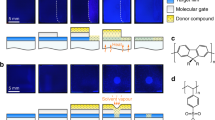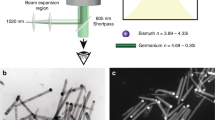Abstract
Advances in techniques for the nanoscale manipulation of matter are important for the realization of molecule-based miniature devices1,2,3,4,5,6,7,8 with new or advanced functions. A particularly promising approach involves the construction of hybrid organic-molecule/silicon devices9,10,11,12,13,14. But challenges remain—both in the formation of nanostructures that will constitute the active parts of future devices, and in the construction of commensurately small connecting wires. Atom-by-atom crafting of structures with scanning tunnelling microscopes15,16,17, although essential to fundamental advances, is too slow for any practical fabrication process; self-assembly approaches may permit rapid fabrication18, but lack the ability to control growth location and shape. Furthermore, molecular diffusion on silicon is greatly inhibited19, thereby presenting a problem for self-assembly techniques. Here we report an approach for fabricating nanoscale organic structures on silicon surfaces, employing minimal intervention by the tip of a scanning tunnelling microscope and a spontaneous self-directed chemical growth process. We demonstrate growth of straight molecular styrene lines—each composed of many organic molecules—and the crystalline silicon substrate determines both the orientation of the lines and the molecular spacing within these lines. This process should, in principle, allow parallel fabrication of identical complex functional structures.
This is a preview of subscription content, access via your institution
Access options
Subscribe to this journal
Receive 51 print issues and online access
$199.00 per year
only $3.90 per issue
Buy this article
- Purchase on Springer Link
- Instant access to full article PDF
Prices may be subject to local taxes which are calculated during checkout



Similar content being viewed by others
References
Aviram, A. & Ratner, M. A. Molecular rectifiers. Chem. Phys. Lett. 29, 277–283 (1974).
Tian, W. et al. Conductance spectra of molecular wires. J. Chem. Phys. 109, 2874–2882 ( 1998).
Reed, M. A., Zhou, C., Muller, C. J., Burgin, T. P. & Tour, J. M. Conductance of a molecular junction. Science 278, 252–254 ( 1997).
Collier, C. P. et al. Electronically configurable molecular-based logic gates. Science 285, 391–394 ( 1999).
Tans, S. J., Verschueren, A. R. M. & Dekker, C. Room-temperature transistor based on a single carbon nanotube. Nature 393, 49– 52 (1998).
Davis, W. B., Svec, W. A., Ratner, M. A. & Wasielewski, M. R. Molecular wire behavior in p-phenylenevinylene oligomers. Nature 396, 60–63 ( 1998).
Ness, H. & Fisher, A. J. Quantum inelastic conductance through molecular wires. Phys. Rev. Lett. 83, 452–455 (1999).
Joachim, C. & Gimzewski, J. K. An electromechanical amplifier using a single molecule. Chem Phys. Lett. 265, 353–355 (1997).
Wolkow, R. A. Controlled molecular adsorption on Si: laying a foundation for molecular devices. Annu. Rev. Phys. Chem. 50, 413– 441 (1999).
Hamers, R. J., Hovis, J. S., Lee, S., Liu, H. & Shan, J. Formation of ordered, anisotropic organic monolayers on the Si surface. J. Phys. Chem. 101, 1489–1492 (1997).
Wolkow, R. A., Lopinski, G. P. & Moffatt, D. J. Resolving organic molecule-silicon scanning tunneling microscopy features with molecular orbital methods. Surf. Sci. 416, L1107–L1113 ( 1998).
Lopinski, G. P., Moffatt, D. J., Wayner, D. D. M. & Wolkow, R. A. Determination of the absolute chirality of individual adsorbed molecules using the scanning tunnelling microscope. Nature 392, 909–911 (1998).
Linford, M. R., Fenter, P., Eisenberger P. M. & Chidsey, C. E. D. Alkyl monolayers on silicon prepared from 1-alkenes and hydrogen-terminated silicon. J. Am. Chem. Soc. 117, 3145–3155 ( 1995).
Cohen, R., Zenou, N., Cahen, D. & Yitzchaik, S. Molecular electronic tuning of Si surfaces. Chem Phys. Lett. 279, 270–274 (1997).
Eigler, D. M. & Schweizer, E. K. Positioning single atoms with a scanning tunnelling microscope. Nature 344, 524–526 (1990).
Avouris, Ph. et al. Atom-scale desorption through electronic and vibrational excitation mechanisms. Surf. Sci. 363, 368– 377 (1996).
Shen, T. C., Wang, C. & Tucker, J. R. Al nucleation on monohydride and bare Si(001) surfaces: atomic scale patterning. Phys. Rev. Lett. 78, 1271–1274 (1997).
Nogami, J. in Atomic and Molecular Wires (eds Joachim, C. & Roth, S.) 11 –21 (Kluwer, Dordrecht, 1997).
Wolkow, R. A. & Moffatt, D. J. The frustrated motion of benzene on the surface of Si(111). J. Chem. Phys. 103, 10696–10700 (1995).
Bozack, M. J., Taylor, P. A., Choyke, W. J. & Yates, J. T. Chemical activity of the C = C double bond. Surf. Sci. 177, 933–937 (1986).
Yoshinobu, J., Tsuda, H., Onchi, M. & Nishijima, M. The adsorbed states of ethylene on Si(100)c(4x2), Si(100)(2x1), and vicinal Si(100)9o: Electron energy loss spectroscopy and low energy electron diffraction studies. J. Chem. Phys. 87, 7332– 7340 (1987).
Mayne, A. J. et al. An STM study of the chemisorption of C2H4 on Si(001)(2x1). Surf. Sci. 284, 247–256 (1993).
Pan, W., Zhu, T. & Yang, W. First-principles study of the structure and electronic properties of ethylene adsorption on Si(100)-2x1 surface. J. Chem. Phys. 107 , 3981–3985 (1997).
Fisher, A. J., Blochl, P. E. & Briggs, G. A. D. Hydrocarbon adsorption on Si(001): When does the silicon dimer bond break? Surf. Sci. 374, 298–305 (1997).
Cicero, R. L., Linford, M. R. & Chidsey, C. E. D. Photoreactivity of unsaturated compounds with hydrogen terminated silicon (111). Langmuir (in the press).
Boland, J. J. Role of bond strain in chemistry of hydrogen on the Si(100) surface. Surf. Sci. 261, 17–28 (1992).
Mo, W., Kleiner, J., Webb, M. B. & Lagally, M. G. Activation energy for surface diffusion of Si on Si(100): A scanning tunneling microscopy study. Phys. Rev. Lett. 66, 1998– 2001 (1991).
O'Driscoll, K. F. & Mahabadi, H. K. Spatially intermittent polymerization. J. Polymer Sci. Chem. 14, 869–881 (1976).
Hitosugi, T. et al. Jahn-Teller distortion in dangling-bond linear chains fabricated on a hydrogen-terminated Si(100)-2 × 1 surface. Phys. Rev. Lett. 82, 4034–4037 ( 1999).
Hata, K., Kimura, T., Ozawa, S. & Shigekawa, K. How to fabricate a defect free Si(100) surface. J. Vac. Sci. Technol. (in the press).
Author information
Authors and Affiliations
Corresponding author
Rights and permissions
About this article
Cite this article
Lopinski, G., Wayner, D. & Wolkow, R. Self-directed growth of molecular nanostructures on silicon. Nature 406, 48–51 (2000). https://doi.org/10.1038/35017519
Received:
Accepted:
Issue Date:
DOI: https://doi.org/10.1038/35017519
This article is cited by
-
Non-covalent interactions in the monohydrated complexes of 1,2,3,4–tetrahydroisoquinoline
Journal of Molecular Modeling (2023)
-
Ordered Patterns of Copper Phthalocyanine Nanoflowers Grown Around Fe Islands on Au(111)
Journal of Cluster Science (2022)
-
A computational study on acetaminophen drug complexed with Mn+, Fe2+, Co+, Ni2+, and Cu+ ions: structural analysis, electronic properties, and solvent effects
Journal of Molecular Modeling (2022)
-
Covalent on-surface polymerization
Nature Chemistry (2020)
-
Nanotip-assisted photoreduction of silver nanostructures on chemically patterned ferroelectric crystals for surface enhanced Raman scattering
Scientific Reports (2019)
Comments
By submitting a comment you agree to abide by our Terms and Community Guidelines. If you find something abusive or that does not comply with our terms or guidelines please flag it as inappropriate.



